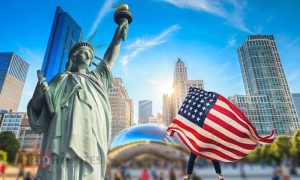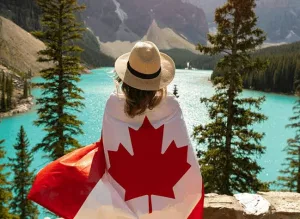
Traveling to the United States without a job offer can be a daunting prospect, but it is entirely possible with the right preparation and understanding of the various visa options available. Whether you are seeking to explore opportunities, study, or simply experience the American way of life, this guide will walk you through the necessary steps and considerations.
Traveling to the USA without a job offer opens up a world of possibilities for those looking to explore new horizons. While having a job offer can simplify the process, there are several other pathways that allow individuals to live and experience life in the United States.
This guide aims to provide detailed information on the available visa options, application processes, and other essential considerations to help you navigate your journey.
Understanding Visa Options
Tourist Visa (B-2)
Purpose: The B-2 visa is designed for individuals visiting the USA for tourism, vacation, or visiting friends and relatives.
- Duration: Generally up to 6 months, with the possibility of extension.
- Requirements:
- Demonstrate the purpose of your visit.
- Provide proof of sufficient funds to cover your stay.
- Show ties to your home country to ensure you will return after your visit.
Application Process:
- Complete the DS-160 form online.
- Pay the visa application fee.
- Schedule an interview at the U.S. Embassy or Consulate in your country.
- Attend the interview with required documentation, including a valid passport, DS-160 confirmation page, visa fee receipt, and supporting documents.
Student Visa (F-1)
Purpose: The F-1 visa is for individuals wishing to study in the USA at an accredited institution, including universities, colleges, and language schools.
- Duration: Duration of the educational program plus Optional Practical Training (OPT) for up to 12 months after graduation.
- Requirements:
- Acceptance into a SEVP-approved institution.
- Proof of financial capability to cover tuition and living expenses.
- Evidence of intent to return to your home country after completing your studies.
Application Process:
- Apply to and get accepted by a SEVP-approved school.
- Receive Form I-20 from the institution.
- Complete the DS-160 form online and pay the SEVIS I-901 fee.
- Schedule and attend a visa interview with required documentation.
Exchange Visitor Visa (J-1)
Purpose: The J-1 visa is for individuals participating in an approved exchange program, including research scholars, professors, and cultural exchange participants.
- Duration: Varies based on the exchange program, typically 1-2 years.
- Requirements:
- Acceptance into a program sponsored by an approved organization.
- Proof of sufficient funds.
- Demonstrate intent to return to your home country after the exchange program.
Application Process:
- Apply and get accepted by an approved exchange program.
- Receive Form DS-2019 from the program sponsor.
- Complete the DS-160 form online and pay the SEVIS I-901 fee.
- Schedule and attend a visa interview with required documentation.
Business Visa (B-1)
Purpose: The B-1 visa is for individuals traveling to the USA for business purposes, such as attending conferences, meetings, or negotiating contracts.
- Duration: Generally up to 6 months.
- Requirements:
- Demonstrate the business purpose of your visit.
- Provide proof of sufficient funds.
- Show ties to your home country to ensure you will return after your visit.
Application Process:
- Complete the DS-160 form online.
- Pay the visa application fee.
- Schedule an interview at the U.S. Embassy or Consulate.
- Attend the interview with required documentation.
Visa Waiver Program (ESTA)
Purpose: The Visa Waiver Program (VWP) allows citizens of participating countries to travel to the USA for tourism or business for stays of 90 days or less without obtaining a visa.
- Requirements:
- Possess an e-passport from a VWP country.
- Apply for ESTA authorization online.
- Demonstrate the purpose of your visit and intent to return to your home country.
Application Process:
- Apply for ESTA authorization through the official website.
- Pay the application fee.
- Receive approval (usually within minutes).
Applying for a Visa
Preparing Your Application
To apply for any visa, you need to prepare thoroughly to increase your chances of approval. Here are the general steps:
- Determine the Correct Visa: Understand the purpose of your travel and choose the appropriate visa category.
- Complete the DS-160 Form: This online form is required for most non-immigrant visas.
- Pay the Visa Application Fee: Fees vary based on the visa type.
- Gather Required Documents: Common documents include:
- Valid passport.
- DS-160 confirmation page.
- Visa fee receipt.
- Passport-sized photograph.
- Supporting documents (financial statements, acceptance letters, etc.).
- Schedule a Visa Interview: Schedule an appointment at the U.S. Embassy or Consulate in your home country.
Visa Interview
The visa interview is a crucial part of the application process. Here are some tips to help you prepare:
- Be Honest and Clear: Answer all questions truthfully and concisely.
- Provide Supporting Evidence: Bring documents that support your case, such as financial statements, letters of acceptance, and proof of ties to your home country.
- Dress Appropriately: Dress in a manner that is professional and respectful.
- Be Prepared to Explain Your Intentions: Be ready to explain the purpose of your visit and how you plan to support yourself financially during your stay.
Financial Considerations
Traveling to the USA without a job offer means you need to be financially prepared to support yourself. Here are some key considerations:
Proof of Funds
You will need to demonstrate that you have sufficient funds to cover your stay. This may include:
- Bank Statements: Showing adequate savings.
- Sponsorship Letters: If someone is financially supporting you.
- Scholarships or Grants: For students.
Cost of Living
The cost of living varies significantly across the USA. Consider these factors:
- Accommodation: Rent can range from affordable in rural areas to very expensive in cities like New York or San Francisco.
- Transportation: Public transport is more accessible in cities; otherwise, you might need a car.
- Food and Utilities: Prices vary, but grocery shopping and dining out can be costly.
- Healthcare: Medical costs are high, and health insurance is essential.
Accommodation and Living Arrangements
Finding suitable accommodation is a major part of your planning. Here are your options:
Short-Term Accommodation
- Hotels and Motels: Suitable for short stays but can be expensive.
- Airbnb: Offers more affordable and home-like options.
- Hostels: A budget-friendly option, especially in cities.
Long-Term Accommodation
- Renting an Apartment: Websites like Zillow, Apartments.com, and Craigslist can help you find long-term rentals.
- Shared Housing: Websites like Roomster and Craigslist can help you find roommates to share rent and living costs.
- University Housing: For students, on-campus housing may be available.
Healthcare and Insurance
Healthcare in the USA is expensive, so having health insurance is crucial. Here are some options:
Health Insurance Options
- Travel Insurance: Short-term visitors can get travel insurance that covers medical emergencies.
- Student Health Insurance: Many universities offer health insurance plans for students.
- Private Health Insurance: For long-term stays, purchasing a private health insurance plan is advisable.
- Employer-Sponsored Insurance: If you find temporary work, your employer may provide health insurance.
Finding Healthcare Providers
- Primary Care Physicians: Establish a relationship with a primary care doctor for routine check-ups.
- Urgent Care Centers: For non-emergency medical issues.
- Hospitals: For emergencies and specialized treatments.
Exploring Opportunities
Even without a job offer, there are many ways to explore opportunities in the USA.
Networking
Building a network can open doors to potential job opportunities and other experiences.
- Professional Associations: Join industry-specific groups.
- Meetup Groups: Attend local meetups in your area of interest.
- LinkedIn: Connect with professionals and join relevant groups.
Volunteering
Volunteering is a great way to gain experience, meet people, and contribute to the community.
- Non-Profit Organizations: Websites like VolunteerMatch can help you find opportunities.
- Community Centers: Local community centers often have volunteer programs.
Temporary Work
Temporary work can provide financial support and valuable experience.
- Temp Agencies: Agencies like Kelly Services and Adecco offer temporary job placements.
- Freelancing: Platforms like Upwork and Fiverr allow you to offer your services remotely.
Studying in the USA
Choosing the Right Institution
Selecting the right institution is crucial for a successful educational experience.
- Accreditation: Ensure the institution is accredited.
- Programs and Courses: Look for programs that align with your career goals.
- Location: Consider the cost of living and lifestyle in different areas.
Application Process
- Research: Identify potential schools and programs.
- Apply: Complete the application process for each institution.
- Standardized Tests: Prepare for and take required tests like the SAT, GRE, or TOEFL.
- Submit Documents: Send transcripts, letters of recommendation, and other required documents.
- Financial Aid: Apply for scholarships, grants, and financial aid if needed.
Cultural Integration
Adapting to a new culture can be challenging. Here are some tips to help you integrate:
- Learn About American Culture: Understand social norms, customs, and etiquette.
- Join Clubs and Organizations: Participate in campus or community activities.
- Make Local Friends: Building relationships with locals can enhance your experience.
- Stay Connected with Your Roots: Maintain connections with your home culture through local communities or online groups.
Legal Considerations
Understanding and complying with U.S. laws is crucial during your stay.
Visa Compliance
- Maintain Valid Status: Ensure your visa status is valid throughout your stay.
- Know Your Rights: Familiarize yourself with your rights as a visa holder.
- Renewals and Extensions: Apply for renewals or extensions well in advance.
Employment Laws
- Authorized Work: Only engage in work that your visa permits.
- Taxes: Understand your tax obligations and file tax returns if required.
FAQs
Can I travel to the USA without a job offer?
Yes, there are several visa options available that do not require a job offer, such as the tourist visa (B-2), student visa (F-1), and the exchange visitor visa (J-1).
What are the financial requirements for traveling to the USA without a job offer?
You need to demonstrate sufficient funds to cover your stay, including accommodation, living expenses, and return travel. The specific amount can vary depending on the duration and purpose of your stay.
How can I extend my stay in the USA?
Depending on your visa type, you may be able to apply for an extension. For example, B-2 visa holders can apply for an extension of up to six months, while F-1 visa holders may extend their stay through Optional Practical Training (OPT).
Can I switch from a tourist visa to a work visa while in the USA?
Switching visa categories while in the USA can be challenging. It often requires leaving the country and applying for the new visa from your home country. Consult with an immigration attorney for specific advice.
What should I do if my visa application is denied?
If your visa application is denied, you can reapply, addressing the reasons for denial. It may also help to seek advice from an immigration attorney to improve your chances of approval.
Conclusion
Traveling to the USA without a job offer is a feasible and rewarding endeavor if approached with proper planning and preparation. By understanding your visa options, preparing thoroughly, and being financially and legally prepared, you can make the most of your time in the United States. Whether you are visiting for tourism, studying, or exploring new opportunities, this guide provides a comprehensive roadmap to help you navigate the process.





